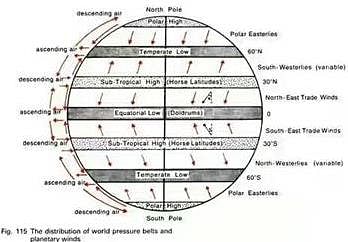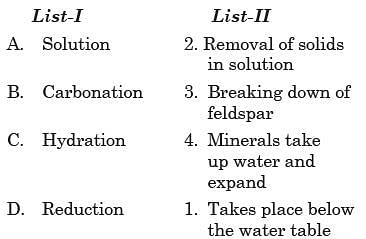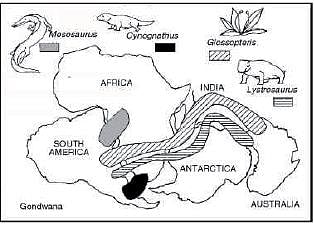Test: Geography NCERT Based Test - 1 - UPSC MCQ
25 Questions MCQ Test - Test: Geography NCERT Based Test - 1
Consider the following statements about the geographical extension of India:
1. The mainland of India extends from Kashmir in the north to Kanyakumari in the south and Assam in the east to Gujarat in the west.
2. The territorial limit extends towards the sea up to 12 nautical miles from the coast.
Which of the above statements is/are correct?
1. The mainland of India extends from Kashmir in the north to Kanyakumari in the south and Assam in the east to Gujarat in the west.
2. The territorial limit extends towards the sea up to 12 nautical miles from the coast.
Consider the following statements:
1. The Danube is the longest river in Europe flowing through 10 countries
2. The highest mountain of Europe, Mount Elbruz, a dormant volcano, is located in the Caucasus range.
Which of the above statements is/are correct?
1. The Danube is the longest river in Europe flowing through 10 countries
2. The highest mountain of Europe, Mount Elbruz, a dormant volcano, is located in the Caucasus range.
| 1 Crore+ students have signed up on EduRev. Have you? Download the App |
We always see the same face of the moon because
Match the following:

Select the correct answer using the code given below:
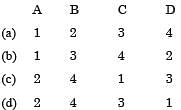
Which of the following is a major impact/effect of salinization on irrigated lands?
Monsoon is active for about six months in Kerala and for less than three Months in Rajasthan because
Which of the following is not an indirect source for studying Earth’s interior?
Consider the given statements regarding Karst topography:
1. A region with a large stretch of limestone topography is termed as a Karst region
2. The name Karst is derived from the Karst district of Yugoslavia on the Adriatic Sea
3. A Karst topography is characterized by surface drainage system with sinkhole and caves
4. Karst regions have bleak landscape usually broken by precipitous slopes
Which of the above statements is/are correct?
Which of the following does not come under Rapid Movements?
Which of the following statements regarding westerlies is not correct?
Which part of India receives rainfall both from Bay of Bengal and Arabian Sea branch of Summer Monsoon?
Consider the following statements regarding Atmospheric Pressure:
1. It is the force per unit area exerted against a surface by the weight of the air below that surface down to the Sea Level.
2. As we go vertically upwards, we feel lower pressure.
Which of the above statements is/are correct?
Which amongst the following is the highest body of navigable water in the world?
Which of the following is not the feature of orographic rainfall?
How is Feldspar different from Pyroxene?
1. Pyroxene has larger share than the Feldspar in the composition of earth’s crust.
2. Pyroxene is green or black in colour, while Feldspar is light cream or salmon pink in colour.
Select the correct answer using the code given below:
Consider the following statements regarding Terrestrial Planets:
1. They have a thick atmosphere, mostly of helium and hydrogen.
2. They are made up of rock and metals and have relatively high densities.
Q. Which of the above statements is/are incorrect?
Match the following:
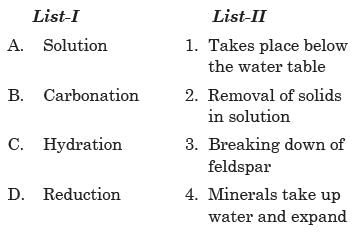
Select the correct answer using the code given below:
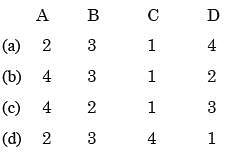
Which of the following evidences support the Continental Drift Theory?
1. Matching of Africa and South America continents.
2. Rocks of the same age across the oceans
3. Absences of source rock in the region of rich placer deposits
4. Distribution of fossils
Select the correct answer using the code given below:
Arrange the following Stages of the evolution of the earth’s atmosphere in chronological order:
1. Process of photosynthesis
2. Loss of primordial atmosphere
3. Hot gases outpoured from the interior
Select the correct answer using the code given below:
Match the following:
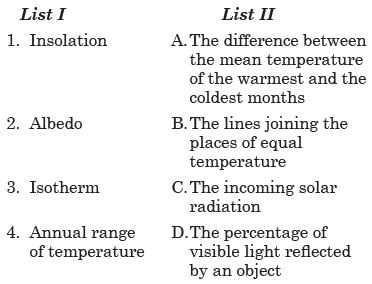
Select the correct answer using the code given below:
The phenomenon of wearing down of relief variations of the surface of the earth through erosion is known as:
Which of the following states get rainfall from northeast monsoon?
Radio waves transmitted from the Earth’s surface are reflected back by which layer of atmosphere?
“This coast has got certain distinguishing features in the form of ‘Kayals’, which are used for fishing, inland navigation and also due to its special attraction for tourists. Every year the famous Nehru Trophy Vallamkali is held in Punnamada Kayal”.The Coast refer in the quotation is?




